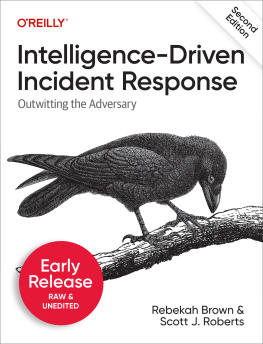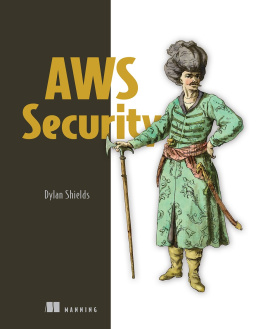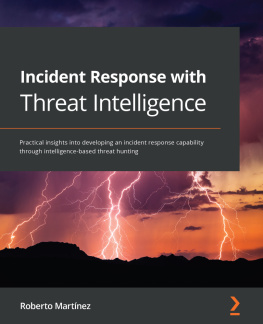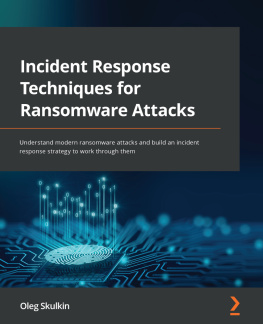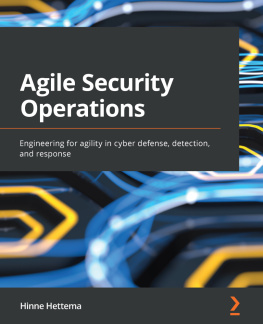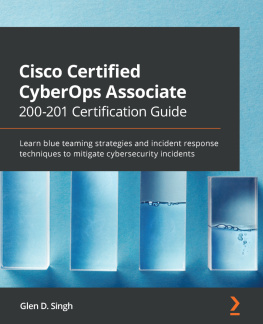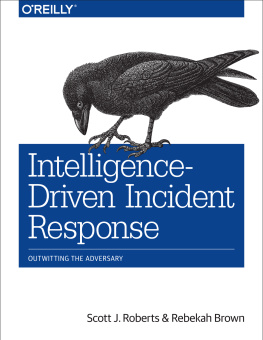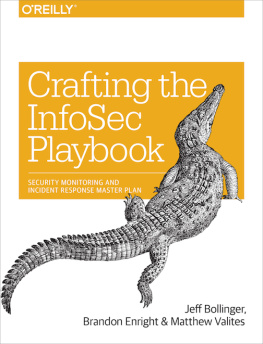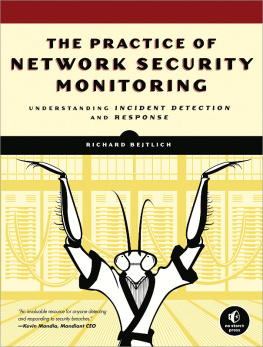Crafting the InfoSec Playbook
by Jeff Bollinger , Brandon Enright , and Matthew Valites
Copyright 2015 Jeff Bollinger, Brandon Enright, and Matthew Valites. All rights reserved.
Printed in the United States of America.
Published by OReilly Media, Inc. , 1005 Gravenstein Highway North, Sebastopol, CA 95472.
OReilly books may be purchased for educational, business, or sales promotional use. Online editions are also available for most titles (http://safaribooksonline.com). For more information, contact our corporate/institutional sales department: 800-998-9938 or corporate@oreilly.com .
- Editors: Mike Loukides, Katie Schooling,
and Amy Jollymore - Production Editor: Kristen Brown
- Copyeditor: Jasmine Kwityn
- Proofreader: Marta Justak
- Indexer: Wendy Catalano
- Interior Designer: David Futato
- Cover Designer: Karen Montgomery
- Illustrator: Rebecca Demarest
Revision History for the First Edition
- 2015-05-06: First Release
See http://oreilly.com/catalog/errata.csp?isbn=9781491949405 for release details.
The OReilly logo is a registered trademark of OReilly Media, Inc. Crafting the InfoSec Playbook, the cover image of an American crocodile, and related trade dress are trademarks of OReilly Media, Inc.
While the publisher and the authors have used good faith efforts to ensure that the information and instructions contained in this work are accurate, the publisher and the authors disclaim all responsibility for errors or omissions, including without limitation responsibility for damages resulting from the use of or reliance on this work. Use of the information and instructions contained in this work is at your own risk. If any code samples or other technology this work contains or describes is subject to open source licenses or the intellectual property rights of others, it is your responsibility to ensure that your use thereof complies with such licenses and/or rights.
978-1-491-94940-5
[LSI]
Foreword
Over the past decade, Ciscos Computer Security Incident Response Team (CSIRT) has participated in countless customer meetings where we sat down and explained how we had protected one of the most attacked and interconnected companies in the world. As we reviewed the tools, people, and process for protecting large organizations, the playbook featured heavily. At the end of each one of these sessions, the group we were sharing with always asked, Can I have a copy of this playbook? We initially distributed some early sanitized versionsbut soon it got too big, too company specific, and too full of things that were impossible to sanitize to share. Now, with this book, we can finally answer yes, you can!
When I started the Cisco CSIRT at the beginning of this century, I had always hoped we could do something that had more relevance than protecting one company. Cisco has benefited from the interconnectivity it has provided, and I felt we had a responsibility to use some of those resources to help protect the same people we had connected. More specifically, I wanted to help groups that may not be able to afford a large CSIRT. Cisco has been very supportive of the teams efforts to share cybersecurity information and has provided resources and time to allow us to realize my hope.
At the time this book was written in 2014, the world witnessed a cataclysmic failure of cybersecurity efforts across the board, with large organizations seemingly hacked at will. Extremely damaging hacks to large retailers, entertainment companies, restaurant chains, and hundreds of others have ushered in the end of reliance on automated incident detection tools like security information and event management (SIEM) systems .
The Cisco CSIRT was at the forefront of the idea that people, not tools, were the answer to protecting organizations. This book details what some of the smartest people in this field have done to detect, identify, isolate, and mitigate cyber security threats. It started simply enoughif we had an incident that we didnt detect, we would look and see if there was any commonality about the attack that we could detect with normally available detection tools (intrusion detection systems, packet capture, logs, etc.). If there was, we would string together a detection method, or play, to look for it. If the play was useful, we would keep it. If not, we would drop it. Then it would eventually be added to the daily work of our security operations center. So the body of work this book represents was baked in the crucible of ongoing attacks and response over a very busy decade.
I am more proud of the work that this team has done than anything else in my professional career. I am really excited they took the time and effort to share the work at this level and depth. The information provided here can be used as a baseline for both new and old teams facing similar challenges. I hope that sharing like this can signal another watershed in the history of cybersecuritywhen the good guys started hitting back.
Gavin Reid
Vice President of Threat Intelligence
Lancope
Preface
If you are reading this, chances are you are looking to enhance your threat detection capabilities and techniques, and up your game as an InfoSec, incident response, and network defender or manager. Threats both in scale, complexity, and profile have evolved dramatically over the last several years and continue to increase. Proper detection and response require a lot more effort and sophistication to remain effective. Building, maturing, and maintaining an effective incident response team is no easy task. We have talked with hundreds of security teams of all types and sizes who are waging the same war between the attackers and their organizations networks, users, and information. Few have done it well, but with a solid strategy, the right expertise, and the right infrastructure, you can compete with the bad guys.
Any good attacker will tell youyour expensive security monitoring and prevention tools are not enough to keep you secure. Successful computer security incident response teams (CSIRTs) realize that intrusions are inevitable, and the best plan is a combination of cultivated threat intelligence, vigilant monitoring for early detection, and rapid and thorough response. Having the right data available in the right tools doesnt mean that the right people are looking at it and responding properly. Operational experience is invaluable and cannot be replaced by a magic black box or a single threat feed.
Our strategy focuses on collecting, organizing, mining, enhancing, and analyzing as many relevant data sources as possible in the hunt for intrusions and security breaches. We call our strategy, this bundle of detection and response methods, the playbook. We have developed a fundamental approach to building a successful incident response program that will detect the inevitable security incidents, minimize damage, yield enough information to share with the incident response community, and prevent successful attacks from recurring.
This book demonstrates how to boil down complex security monitoring, incident response, and threat analysis ideas into their most basic elements. Using a data-centric approach, we share how to create or refine your own unique incident detection strategy, how to keep your ideas and methods fresh, how to discover and develop your own threat intelligence, and how to compete against the malicious actors already attacking your network.
Should You Read This Book?
This book is for IT and information security (InfoSec) professionals, particularly incident or emergency response teams, InfoSec managers or directors, and IT architects, who want to either develop a nascent security monitoring and incident response program or evolve their existing program to a modern, more effective approach.

![Bollinger Jeff Crafting the infosec playbook [security monitoring and incident response master plan]](/uploads/posts/book/193800/thumbs/bollinger-jeff-crafting-the-infosec-playbook.jpg)
